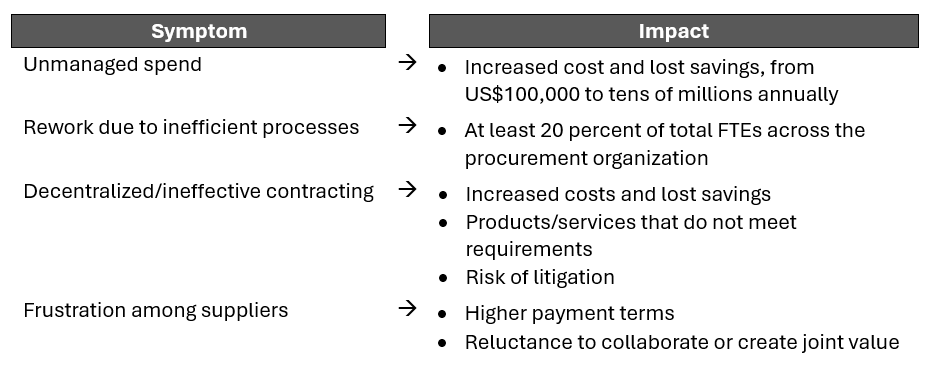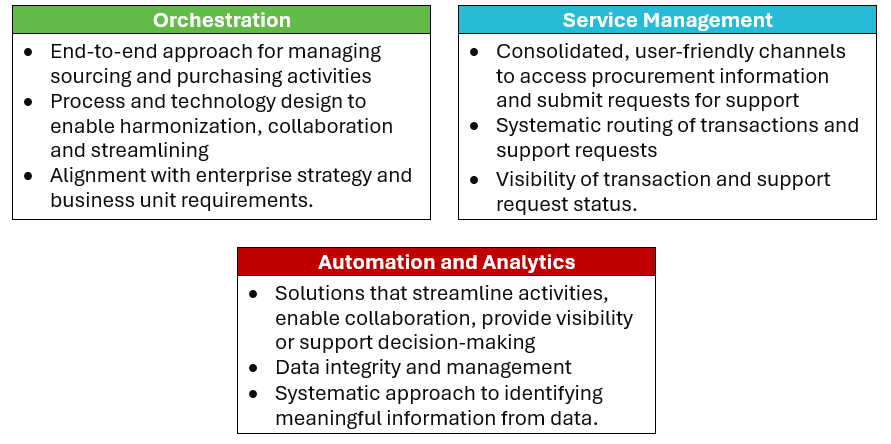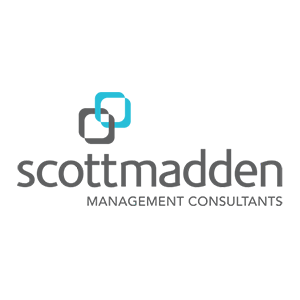Designing for the Future by Transforming Procurement

Today’s procurement organizations often face internal and external challenges that can impact efficiency and effectiveness.
Internally, common pain points include (1) unclear roles for procurement staff due to combined strategic and transactional activities, (2) non-standard, manual processes, (3) lack of policy compliance and (4) business users’ uncertainties about how to access procurement services. In addition to these internal issues, procurement organizations must deal with rising prices, supply chain disruptions, more stringent regulations and ever-increasing customer demands.
These issues and challenges emerge as symptoms of underperformance, which are often quantifiable. Examples include:
In the 1990s, companies began implementing practices like spend analysis, demand aggregation and category management, which provided efficiency and led to strategic procurement. Since then, incremental process improvements and technology enhancements have continued to yield benefits; however, many procurement organizations still struggle with inefficiencies and underperform in today’s volatile environment.
Companies have realized that business transformation can be an effective strategy to address internal issues and external challenges. Business transformation refers to the fundamental changes an organization makes to its operations, strategies, processes, technologies and culture to support its strategy, growth plans or adaptation to market conditions.
In procurement, a transformation involves improvement in three areas: orchestration, service management, and automation and analytics. The three areas are outlined below.

Objective and Key Design Considerations
A successful transformation begins with defining the objectives, such as:
- Realigning to support a new business or other strategic initiative
- Improving procurement effectiveness (for example, increasing managed spend, improving service delivery, and better leveraging suppliers)
- Mitigating risks
- Improving the ability to respond to supply disruptions and demand changes
- Incorporating environmental, social and governance (ESG) priorities.
A well-defined set of transformation objectives guides planning and decision-making, ensures resources are leveraged appropriately, and garners stakeholder buy-in.
After validating the objective, designing the future operating model is the next step. A deep understanding of stakeholders’ procurement requirements, customer groups, and preferred delivery channels is foundational to good design. This understanding informs the design of processes, organization, and technology.
Typical questions addressed during design include:
- How can we structure processes to separate transactional purchasing from sourcing, contracting and strategic procurement?
- What organization design best supports the future state processes?
- What procurement information should we provide to internal customers and suppliers?
- How can we provide end-to-end visibility of procurement requests and transactions?
- What are typical questions and issues from internal customers and suppliers?
- How should we incorporate strategies for ESG, supply chain resilience, circularity and/or risk management?
- What are the priority areas for technology investment?
- How can we establish more strategic relationships with our important suppliers?
Addressing these questions provides guiding principles for future design and incorporates leading practices in orchestration, service management and automation.
Since a procurement transformation affects all organizations and all suppliers, identifying subject matter experts and stakeholders who will participate in design sessions and provide input on user experience is critical.
Implications for Procurement Organizations
As described above, procurement organizations face challenges due to ineffective models, increasing demands and a more complex and volatile business environment. Many companies recognize that a business transformation can address these challenges but do not know how to begin or where to focus their time and resources.
Measuring baseline performance through an operations assessment is a good way to start an improvement journey. An operations assessment provides a complete view of performance, identifies the highest-impact opportunities and enables executives to pursue a clear path to improve performance.
Companies that want to implement a leading practice, high-performing and agile operating model need experienced partners to lead them on this journey. ScottMadden is actively working with our clients to transform their procurement organizations. To learn more, visit www.scottmadden.com.



